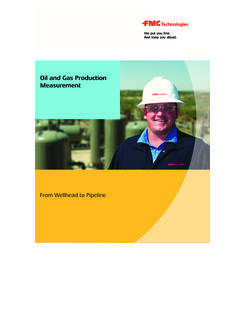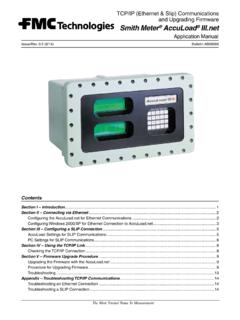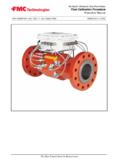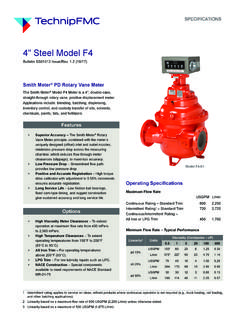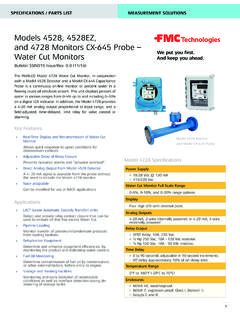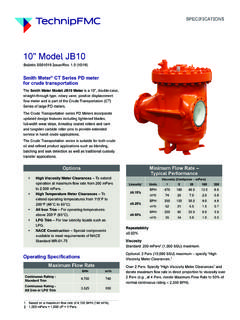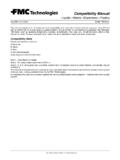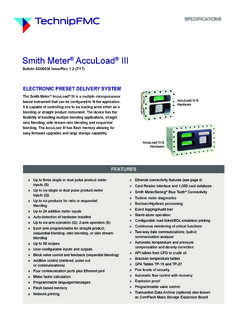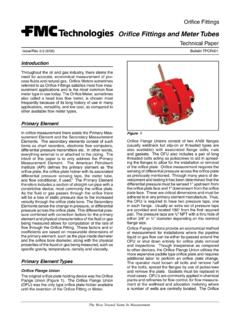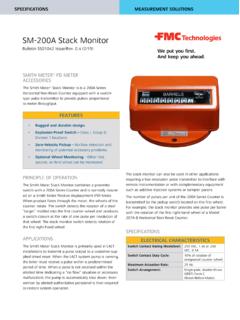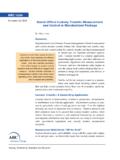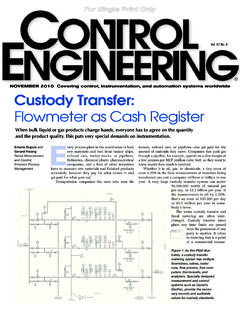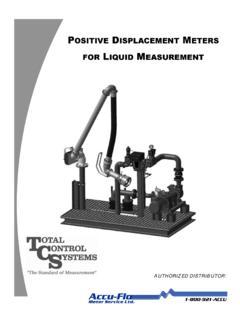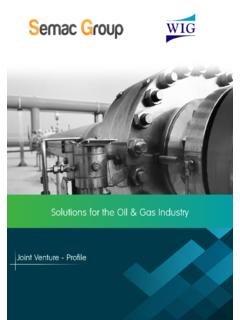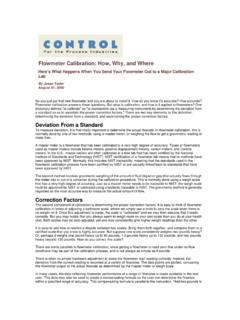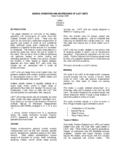Transcription of General Metering - FMC Technologies
1 Technical PaperGeneral MeteringA Comparison of Liquid Petroleum Meters for custody transfer MeasurementIssue/Rev. (3/05) Bulletin TP0A014 The Most Trusted Name In Measurement Introduction Petroleum products bought and sold on the world wide market may be transported over thousands of miles and change ownership many times from the well head to the end user. Each time the product changes owner-ship, a custody transfer is completed and both buyer and seller expect their asset share to be accurately measured.
2 The dynamic measurement provided by meters is a convenient and accurate means to measure valuable petroleum products. Selecting the right meter for the job with a high level of confidence is imperative to ensure accurate measurement at the lowest the cost of ownership. Meter SelectionTypical petroleum applications where measurement is required include: production, crude oil transportation, refined products transportation, terminal loading, fuel oil tank truck loading and unloading, aviation and lube oil blending.
3 Each of these applications is unique and a specific type of meter may be better suited for each application. Selecting the correct meter for a specific measurement task is dependant on the following oper-ating conditions:System characteristics Pressure and temperature are typically specified but other characteristics such as pulsating flow from a PD pump or valve operation / location should also be considered as they may cause measurement errors for some types of meters. Product characteristics The basic product charac-teristics of viscosity, specific or API gravity, chemical characteristics and lubricating quality must be speci-fied.
4 Also, any contaminates such as particulates, air or water contained in the product must be identified and noted in an application range This is the minimum and maximum flow rate over which the meter will operate. The flow range can also be expressed as the turndown range , which is the ratio of the maximum to the minimum flow rate ( , a flow range of 10 bph to 100 bph is a 10:1 turndown range). Viscosity Range Just as the flow range can be expressed as a turndown range, so can the maxi-mum to the minimum viscosity be expressed as a turndown range.
5 Accuracy The Accuracy of a liquid flow meter depends predominantly on the flow range and the viscosity range of the products over which the meter operates. The following formula relates Flow Turn-down Range to Viscosity Turndown Range to yield a Measurement Turndown Range (MTR). Comparing the MTR of various meter types for specific operating conditions provides a guide to selecting the meter with the best potential accuracy for the Turndown Range = Flow Turndown Range x Viscosity Turndown RangeorMTR = FTR x VTR Meter Accuracy Requirements and CriteriaAccuracy requirements for the wholesale and retail trade are normally defined by the weights and measures regulations in the country or jurisdiction in which the sale is conducted.
6 Sales within the petroleum industry that are not normally defined by weights & measures, but by a contract between the trading parties, are known as custody transfer transactions. A typical contract may define a specific measurement standard such as one of the American Petroleum Industry (API) Standards. Cur-rently API recognizes four types of dynamic measuring devices Positive Displacement (PD) Meters, Turbine Meters, Coriolis Mass Flow Meters (CMFM s) and re-cently approved Liquid Ultrasonic Flow Meters (LUFM s).
7 The API Standards are based on best practice and define the proper application of a specific flow meter. Contracts are also based on other recognized standards but all these standards have one thing in common - they all strive to minimize measurement error for a specific is defined as the difference between the measured quantity and the true value of the quantity. There are four (4) types of errors: Spurious error merely mistakes or blunders that must be identified and eliminatedRandom error variations at constant conditions, nor-mally evenly distributed about a mean, which can be statistically analyzed and eliminatedConstant systemic error a bias that is particular to an installation.
8 These errors include hydraulic and zero calibration effectsVariable systemic error a bias that varies with time and includes bearing wear or changes in : Systemic errors can only be determined and accounted for by onsite proving at operating criteria associated with custody transfer and all accurate measurement includes: Repeatability the variation of meter factor under stable operating conditions, , constant flow rate, temperature, pressure, and viscosity. The typical re-quirement is that a meter must repeat within +/- Issue/Rev.
9 (3/05)Page TP0A014in 5 consultative runs. A more General statement is the meter should be repeatable within +/- 7% at 95% confidence level. This more General statement allows a wider repeatability test tolerance. For ex-ample, a repeatability of +/ - % in 10 consecutive runs or a repeatability of +/- in 15 consecutive runs both meet +/- 7% at 95% confidence level. This latter definition of repeatability is important in testing Coriolis and Ultrasonic Flow meters, because sampling type meters normally require more runs to satisfy the repeatability requirement.
10 Linearity the variation of meter factor over a flow range at constant temperature, pressure and viscosity. Stability or Reproducibility the variation of meter factor over time. Unlike repeatability runs where con-ditions can be kept nearly constant, operating condi-tions over time may have wider variations. Therefore, it is important that the meter selected have minimum sensitivity to operational variations to achieve required accuracy. For example, if heating oil with a viscosity range of cSt to 10 cSt over the operating tempera-ture range (see Appendix A) is being loaded at 100 to 500 gpm, the meter must be stable over a 5:1 flow range and a 5:1 viscosity range which is a measure-ment range of 5:1.
